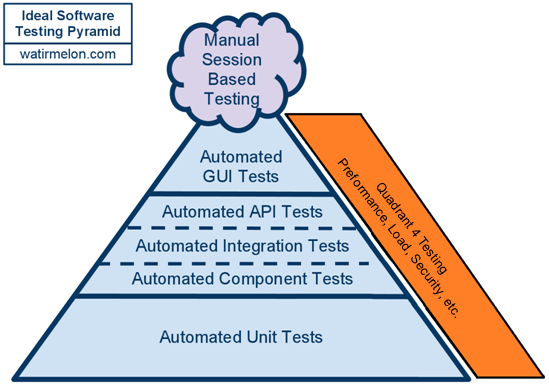Typical response: "Wait. How do developers help with my testing? And did you say the business? I thought testing was only about making sure the requirements were built and the system still works."
Over the years I too have struggled with the question of what to test. Product Risk Analysis (PRA's) have helped me considerably to focus in on those areas of highest risk. Every discussion I have about what to test has a discussion about PRA's in it somewhere. But my real ah-ha moment came when reading Succeeding With Agile by Mike Cohn. Mike laid out the automation testing triangle; which spoke of 3 layers of tests:
- Automated GUI Tests
- Automated Integration Tests
- Automated Unit Tests
But there was something missing. During sprints I am often asked "When do we do Performance Tests?" Being the anti-technical debt person I am I always answered "by the end of the sprint." While this answer worked it didn't satisfy me much because it was a test, an automated test even, but didn't fit in the pyramid. The tests in question fall into Quadrant 4 of Brian Maricks Testing Quadrants. All are technology-facing tests which critique the product and are almost always automated. They include: security testing, performance & load testing, data migration testing, "ility" tests (scalability, maintainability, reliability, installability, compatibility, etc.). But what to do with them?
 The solution I came up with is the addition of Q4 Tests to the side of the testing pyramid. This simple addition now provides a home on the pyramid for every type of test created.
The solution I came up with is the addition of Q4 Tests to the side of the testing pyramid. This simple addition now provides a home on the pyramid for every type of test created.My new testing pyramid also shows testers that you can do Q4 tests at any level of the pyramid. For example, you do not have to wait until the end of the Sprint to do all of your Performance testing. You can begin by tracking execution times for each Unit, Integration and GUI test. This will give you a first insight into performance; you could also have the developers run "best practice" evaluation tools against their code to help determine maintainability, etc.; you can certainly load test various components and the GUI as functionality is added.
I now share this updated pyramid every shop I go into.
No comments:
Post a Comment